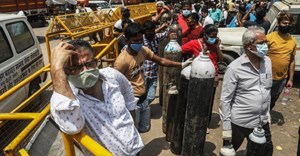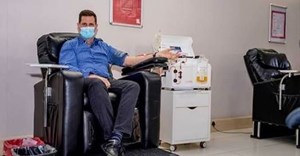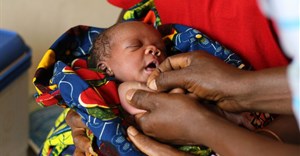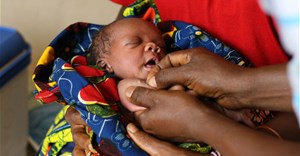Trending
Elections 2024
Jobs
- Middle-weight Graphic Designer Cape Town
- Brand Ambassador Nelspruit
- Social Media Manager Cape Town
- Delivery Director Sandton
- Brand Promoter Barberton
- Printing Sales Account Executive Johannesburg
- Sales Executive/Design and Display Industry Johannesburg
- Designer Cape Town
- Junior Orders Processing Clerk (Junior Estimator) Durban
Pneumonia, the 'silent' killer
World Health Organisation (WHO) data show that in 2000, there were an estimated 14.5 million cases of pneumococcal disease worldwide, responsible for death in 826 000 children under the age of five. 95% of disease was attributable to pneumonia.
Developing countries, where children have the highest risk for pneumonia, require the most urgent prevention programs. While the majority of pneumococcal cases (51%) were in Asia due to the high population, 54% of pneumococcal deaths occurred in Africa, where the lack of vaccines, a high prevalence of HIV infection and lack of access to medical care were contributory.
Expanded Programme on Immunisation
At a meeting held on Friday 22 October 2010, the Southern African Society for Paediatric Infectious Diseases (Saspid) provided an update on developments regarding increased access to immunisation in helping to achieve the (MDG no.4) Millennium Development Goal of 'reducing childhood mortality caused by Pneumococcal disease by two-thirds by 2015.'
Pneumococcal disease describes a group of illnesses caused by the bacterium Streptococcus pneumoniae. The bacteria colonise the upper respiratory tract and can spread to other sites in the body, resulting in several different types of disease: invasive pneumococcal disease (IPD) and non-invasive pneumococcal disease. Groups of Pneumococci have slightly different coats (capsules) called "serotypes". Each group neutralised by its own specific antibodies.
The pneumococcal conjugate vaccine protective against 7 serotypes (PCV7) was introduced into the Expanded Programme on Immunisation in South Africa in April 2009. Despite low, estimated vaccine coverage of PCV and a high HIV prevalence, GERMS-SA has already demonstrated a significant decrease in serotype-specific, invasive pneumococcal disease amongst South African infants. These early direct effects are likely to be amplified as vaccine coverage increases.
Wear blue
For availability of the vaccine, support of the pharmaceutical industry, and also approval by WHO are essential. This process has given access for the vaccine to South African children.
In support of World Pneumonia Day, scheduled for 12 November, we encourage members of the public to wear blue jeans and blue T-shirts, symbolising that we support the prevention of childhood pneumonia. We commit ourselves to drive awareness pro-actively about this tragic disease which claims approximately two million babies and toddlers lives every year.
Pneumococcal disease
According to the WHO, pneumococcal disease is the leading cause of vaccine-preventable death worldwide in children younger than 5 years and is estimated to cause up to 1.6 million deaths worldwide in children each year.
Pneumococcal disease is complex and describes a group of illnesses; all caused by the bacterium Streptococcus pneumonia. Pneumococcal disease affects both children and adults , and includes pneumonia, bacteremia/sepsis, meningitis and acute otitis media.
SASPID
The Southern African Society for Paediatric Infectious Diseases (SASPID) was established at the biennial conference of the South African Paediatric Association on 31 May 2008. A constitution was adopted after input from colleagues. The Society is affiliated to FIDSSA (Federation of Infectious Diseases Societies of Southern Africa) and also the World Society for Paediatric Infectious Diseases.
SASPID's aims:- To advance the understanding of paediatric infectious diseases.
- To promote the exchange of information relating to all aspects of paediatric infectious diseases.
- To foster greater collaboration between the clinical and laboratory based disciplines: These include Adult Infectious diseases, Medical Virology and Medical Microbiology and Infection Control.
- To promote the development and exchange of knowledge, information and ideas in support of the prevention and control of hospital and community associated paediatric infections.
- To advise with regard to the training and maintenance of standards within the disciplines.
- To forge links with societies representing similar interests throughout the world.
- To promote a family-based approach to infectious diseases in the community.
- To work towards an African Society for Paediatric Infectious Diseases.
Sources
1. Pneumonia: The forgotten killer of children; United Nations Children's Fund (UNICEF)/World Health Organisation (WHO), 2006. Download from www.who.org
2. World Pneumonia Day Organisation. (www.worldpneumoniaday.org)
3. O'Brien L, Wolfson J L, Watt P J, et al Burden of disease caused by Steptococcus pneumonia in children younger than 5 years: global estimates. Lancet, 374, Issue 9693, Pages 893-902, 12 September 2009:



















